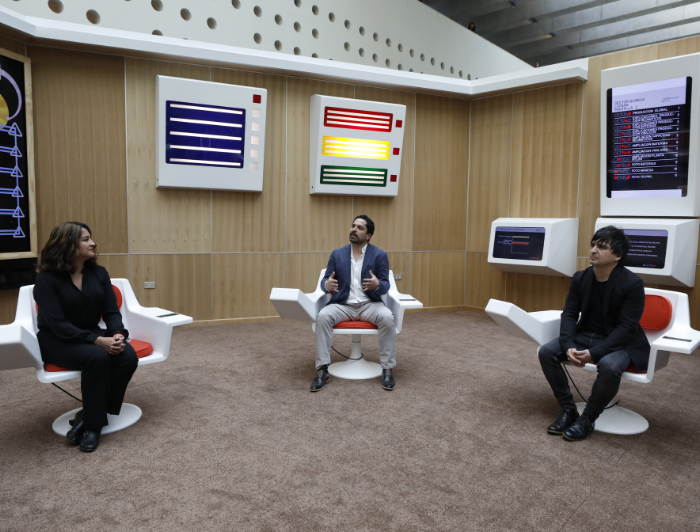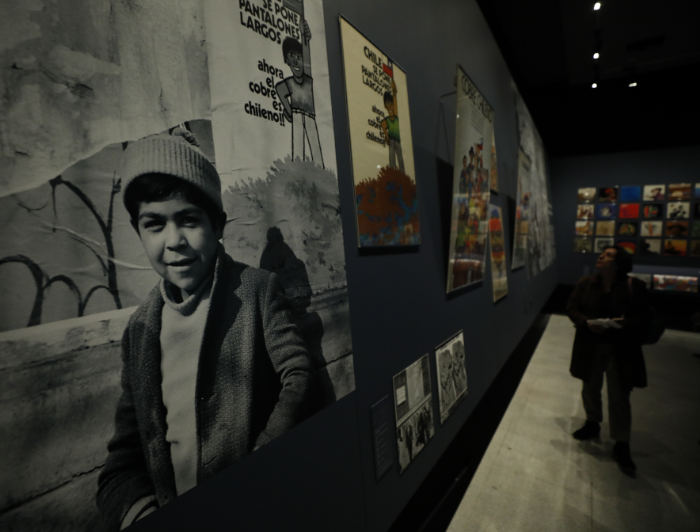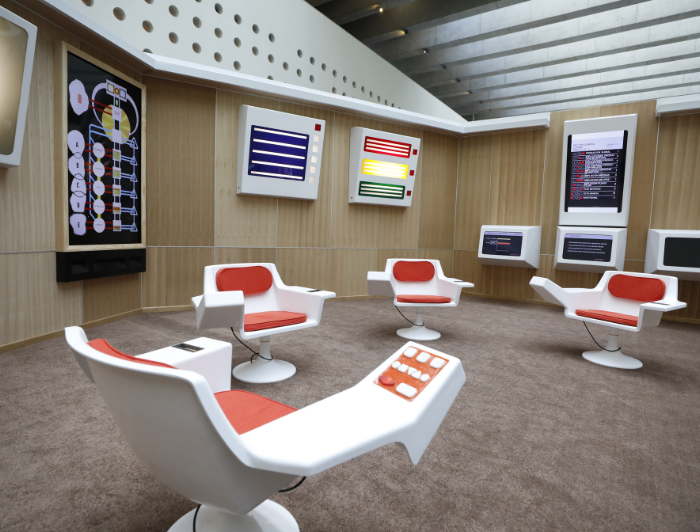How to Design a Revolution? Unveiling Chilean Design and Industrial Aesthetics in the 70s
The exhibit at La Moneda Cultural Center was curated by professors Hugo Palmarola and Pedro Alonso from UC Chile and Eden Medina from MIT.

photo_camera The exhibition launched a new analysis of this period, key for Chile and the world. With 350 pieces, it includes the first reconstruction of the Cybersyn Operations Room, a pioneering cybernetics project. Credits: César Cortés.
The seating in the hexagonal room is reminiscent of great sci-fi productions like 2001: A Space Odyssey and Star Trek. However, this is actually the reconstruction of the Cybersyn Operations Room created during the Popular Unity government, which today is part of the exhibition "How to Design a Revolution: The Chilean Way to Design" at the La Moneda Cultural Center (CCLM, as per Spanish acronym).
The exhibition shows graphic and industrial designs made during the government of President Salvador Allende (1970-1973). It was produced jointly by UC Chile, the Massachusetts Institute of Technology (MIT), and the CCLM, collaborating with the Ministry of Science, Technology, Knowledge, and Innovation and the Goethe-Institut Chile.
"For UC Chile, it is a source of great pride to be at this inauguration. The exhibition explores the process that Chilean design underwent during those years, with milestones such as the Larrea brothers' album covers of the Nueva Canción Chilena and innovations for housing and health. This exhibition allows us to see how graphic design played a key role in the development of society," said UC Chile President Ignacio Sánchez during the inauguration in the company of various government authorities, including Interior Minister Carolina Tohá.
"On behalf of myself and the Government of Chile, I wish to express our gratitude for your collective effort in bringing this exhibition to fruition. It embodies the essence of what we hoped to achieve in commemorating the 50th anniversary of the coup d'état. It is a testament to the power of collaboration from diverse perspectives and a reminder to approach our history with curiosity and a genuine desire to understand one another. For those of us who hold this date close to our hearts, this exhibition serves as a guiding light for approaching the future, fostering mutual understanding, and promoting collaboration among institutions," said Tohá.
Curated by UC professors Hugo Palmarola and Pedro Ignacio Alonso and Professor Eden Medina from MIT, the exhibition gathers original design pieces aimed at collective action, the democratization of reading and music, the reduction of technological dependence, and overcoming child malnutrition.
The exhibit also features the first comprehensive and functional reconstruction of the Cybersyn room, the work of the exhibition curators. Today, located near the government palace, the building where Cybersyn planned to set up shop 50 years ago, this reconstruction takes on special significance and opens up new perspectives for analysis.
"In the Cold War, Chile pioneered in proposing an alternative to U.S. capitalism and Soviet socialism, creating a third way not only economically, but also in its graphic and industrial creation," said the curators.
The exhibition offers a comprehensive and nuanced exploration of the visual and material culture during a pivotal historical moment. It highlights the groundbreaking endeavor of ushering in a revolution through the electoral process, marking the initial response of a nation to a crucial question in global design: how to integrate socialism and democracy into design. "In the Cold War, Chile pioneered in proposing an alternative to U.S. capitalism and Soviet socialism, creating a third way not only economically, but also in its graphic and industrial creation," said the curators.
Revolutionary Design

"How to Design a Revolution: The Chilean Way to Design" is part of the activities to commemorate the 50th anniversary of the civil-military coup d'état in Chile. "A new look at the hopes placed in the future imagined by the political-social and design project led by Salvador Allende. At the time, the pieces exhibited aimed to improve the living conditions of the population through projects that sought to implement graphic and industrial design in the promotion of public policies of high social impact."
For Regina Rodríguez Covarrubias, director of the La Moneda Cultural Center, this is the most important exhibition of the year. "In the framework of the 50th anniversary of the civil-military coup, this exhibition speaks to us from a little-explored place, beyond the trauma of the coup and the dictatorship. It allows us to know and value an avant-garde Chile that used its creative resources to democratize culture, educate, and build bonds of coexistence in favor of equity and innovation."
"While the country still grapples with the pressing and inevitable tasks related to human rights violations during the dictatorship, it shouldn't deter us from drawing upon our personal and collective memories. We can reclaim what we've achieved through collaborative efforts. Chile is a country full of creativity, and we deserve to have the visual and material culture generated through design put at the center of the local and global debate for the creators and communities."
"This exhibition speaks to us from a little-explored place, beyond the trauma of the coup and the dictatorship. It allows us to know and value an avant-garde Chile that used its creative resources to democratize culture, educate, and build bonds of coexistence in favor of equity and innovation." - Regina Rodríguez, director of the La Moneda Cultural Center.
The carefully selected pieces in this exhibit constitute the materialization of the most outstanding episodes of the "Chilean Road to Socialism." According to the curators: "Exposing the history of design during Salvador Allende's government, 50 years after its violent end, provides us with an opportunity to appreciate the significance of a pivotal moment in Chile and the world. It helps us understand what the dictatorship destroyed, dismantled, and rendered impossible with the September 11, 1973 coup. This included replacing public policies focused on social development and industry in favor of imposing what would become the initial experiment of neoliberalism on a national scale."

The exhibition gathers for the first time the most significant of Chilean design through pieces such as the posters of the Larrea brothers' Office together with their album covers for the Nueva Canción Chilena; the books and magazines of Editorial Quimantú; the graphic design of Santiago Nattino for the technical education of farmers; the posters of Waldo González and Mario Quiroz for the National Health Service; the innovations of products for housing, agriculture, electronics and health of the Industrial Design Area INTEC; the productive adaptations of industrial workers; as well as the editorial work of the Taller Gráfico UTE and its posters for the exhibition inaugurated by Salvador Allende and Víctor Jara on September 11, 1973.
The exhibition also highlights the work of pioneering women designers in Latin America in projects for the data visualization of the Cybersyn Operations Room and for the signage of UNCTAD III developed by Eddy Carmona, Jessie Cintolesi, Pepa Foncea, and Lucia Wormald, and the didactic toys of Marisol Navarro for the Institute of Applied Psychology.

The Minister of Science, Technology, Knowledge, and Innovation, Aisén Echeverry, said the following about the importance of the Cybersyn project: "The story of Cybersyn has to be observed and analyzed with great attention by all those who care about technology because it opened the reflection on what it means in the economic, political, and cultural development of a country. This was a case of experimentation within the State and is a milestone that those interested in innovation and technology should be aware of. That's why we appreciate Cybersyn being part of this exhibition."
A specialized book covering the exhibition's topics will be published in Spanish and English. The volume will be published and distributed internationally by the renowned Swiss publisher Lars Müller Publishers. It will feature articles by leading design, technology, Chilean history, and visual and material culture researchers.


